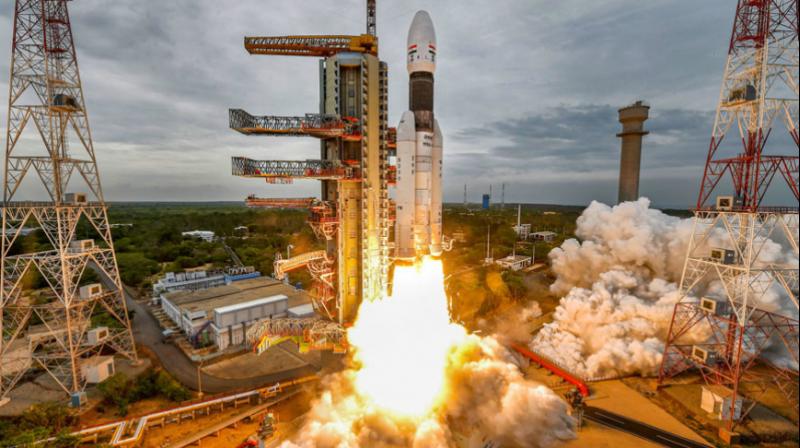Chandrayaan-2: Down the memory lane
A team at ISRO Telemetry, Tracking and Command Network has been desperately trying to restore the link with the lander.

In the early hours of September 7, 2019 India was on the brink of making history when India's space programme suffered a major setback with Chandrayaan 2’s lander Vikram, with rover Pragyan housed inside it, lost communication with the ground station during its final descent minutes before the planned touch down on the lunar surface. Vikram, 1,471-kg lander of Chandrayaan-2 , named after Vikram Sarabhai, the father of India's space programme, represents India’s maiden mission to explore the lunar terrain with indigenously developed technology.
A team at ISRO Telemetry, Tracking and Command Network has been desperately trying to restore the link with the lander and even claimed to have spotted the lander on the lunar surface on September 8 by camera-on-board of the Chandrayaan-2 orbiter The lander Vikram, designed to execute a soft landing on the lunar surface, unfortunately had a hard landing and the impact shock might have possibly caused damage to the lander according to a top ISRO official. The lander and the rover had a mission life of just one lunar day, equivalent to 14 earth days. Therefore the ISRO had hardly a week to restore Vikram back to life. With the available power in the battery draining out rapidly hopes of salvaging the lander-rover were fading day by day and finally on September 17, the ISRO issued the following statement: “Thank you for standing by us. We will continue to keep going forward-propelled by the hopes and dreams of Indians across the world.', with the graphic of an imposing looking moon the silhouette of a man jumping across a cliff with the words” Thank you for inspiring us to always to aim for the sky.” .Though the mission might not have been a success, “this is no mean achievement at all,” Prime Minister Shri Narendra Modi, had then tweeted.
The Indian Space Research Organisation has come a long way since 1981 when the space scientists had to load the satellite into a bullock cart while preparing for the launch of the country's first communication satellite, Ariane Passenger Payload Experiment (Apple), from the Guiana Space Centre in France. This was a time when the ISRO did not even have mainframe computers at its Mission Control Centre at Sriharkota in Andhra Pradesh. This mission that had laid the foundation for the indigenous development of INSAT and GSAT series faced several challenges. Shri R.M. Vasagam, project director APPLE, in one of his research papers has noted, “We were close to the point of transporting the satellite to Toulose in France for final tests to be followed by launch from Kourou. Since that would have resulted in considerable expenditure and time delay, a solution was found in just five hours and at a cost of Rs.150 by placing APPLE on a bullock cart to provide a non-magnetic environment and to conduct the antenna test in an open field to remedy the TT&C problem caused by impedance matching problem. APPLE was India's first geostationary experimental satellite communication Project Satellite during 1977-83 and was successfully launched by Arianne I from Kourou in French Guiana on June 19, 1981.
As noted by Shristhi Chudhary on July 29 in Live Mint, the spacecraft was designed and built just two years in industrial sheds with very limited infrastructure and it led to the development of a large constellation of satellites in INSAT an GSAT series that revolutionized the technological and economic growth of the country.
A comical tail piece: when Rohini RS D1 a 38-kg experimental spin stabilized satellite was placed in the orbit on May 31, 1981, ISRO chairman Shri Satish Dawan had sent his joint secretary Shri T.N. Seshan (later Chief Election Commissioner of India) to brief Shrimathi Indira Gandhi about this achievement and Mrs. Gandhi who was preoccupied asked Seshan to request Shri Uma Shankar Dixit to make a statement in the Rajya Sabha. Shri Dixit asked Seshan how many men were inside the satellite. When Seshan said “none”, Dixit quipped: “Is there at least a monkey? “ When Seshan replied in the negative, Dixit saw no need for a statement unless he was permitted to say when exactly India would send a manned space craft, Seshan told Dixit “To be honest I can assure you that it is not going to happen during your life time “and went back to meet Shrimathi Gandhi who called Dixit over phone and persuaded him to make the statement. Dixit agreed on one condition that she should take action against Seshan for being so rude to him and Mrs Gandhi agreed. She narrated this to Seshan followed by a loud laughter.
(The writer, a retired IAS officer of Tamil Nadu cadre, served as Member, State Planning Commission & Additional Chief Secretary to Government of Tamil Nadu)

